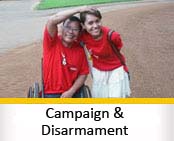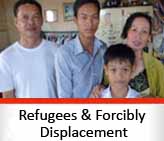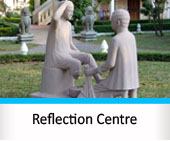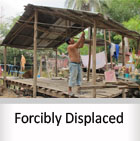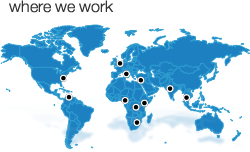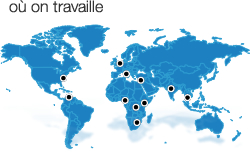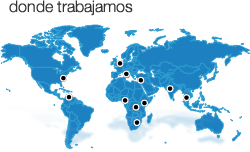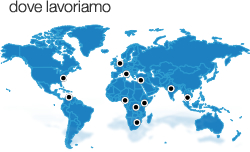Refugees
JRS definition
In deciding with whom to work, JRS feels that the scope of existing international conventions is too restrictive. It therefore applies the expression 'de facto refugee' to all "persons persecuted because of race, religion, membership of social or political groups"; to "the victims of armed conflicts, erroneous economic policy or natural disasters"; and, for "humanitarian reasons", to internally displaced people, that is, civilians who "are forcibly uprooted from their homes by the same type of violence as refugees but who do not cross national frontiers."
1951 UN Refugee Convention
There are many definitions of a refugee, ranging from the most restrictive to the most inclusive. After the Second World War, the UN member states drew up what is now known as the 1951 UN Convention Relating to the Status of Refugees. It originally applied to those who were displaced in Europe before 1951. In 1967, a protocol to the Convention removed the temporal and geographical restrictions.
The Convention defines a refugee as a person who
Owing to a well-founded fear of being persecuted for reasons of race, religion, nationality, membership of a particular social group, or political opinion, is outside the country of their nationality, and is unable to or, owing to such fear, is unwilling to avail him/herself of the protection of that country.
Other refugee definitions
Since the above definition refers only to individuals in fear of persecution, regional organisations in both Africa (African Union 1969) and Latin America (Organisation for American States 1984) have developed wider definitions which include mass displacements which occur as a result of social and economic collapse in the context of conflict.
Internally displaced people
Internally displaced people are "persons or groups of persons who have been forced or obliged to flee or to leave their homes or places of habitual residence, in particular as a result of or in order to avoid the effects of armed conflict, situations of generalised violence, violations of human rights or natural or human-made disasters, and who have not crossed an internationally recognised State border." (Guiding Principles on Internal Displacement, Introduction, paragraph 2).
The majority of forcibly displaced people in the world are displaced within their countries of origin. Nearly 12 of the 26 million persons internally displaced are from Africa, in particular Central African Republic, Chad, Democratic Republic of Congo and Sudan.
Asylum seekers
An asylum seeker is an individual who has made an application for protection but whose application has not yet been determined. If an asylum seeker's application is successful, s/he is then recognised as a refugee, and this confers certain rights and obligations according to the legislation of the receiving country.
The practical determination of whether a person is a refugee is left to certain government agencies within the host country or to the UN refugee agency (UNHCR). The percentage of successful asylum applications varies from country to country, even for the same nationalities. After waiting years for their claims to be processed, many asylum applicants who receive a negative response to their application cannot be returned home, leaving them in a certain limbo. Unsuccessful asylum seekers who do not leave the host country are thereafter usually considered to be undocumented migrants. Asylum seekers, particularly unsuccessful applicants, are increasingly held in detention centres, particularly in Europe and the US.
It can often be virtually impossible for asylum seekers to leave their countries of origin with adequate documentation and visas. Therefore, most asylum seekers are forced to undertake often expensive and hazardous journeys to enter countries irregularly where they can seek and be granted refuge.
Prima facie refugee
In response to conflicts and mass human rights abuses, individuals often flee countries en masse. In these circumstances, it would be impractical and unnecessary to examine each individual asylum application. These individuals are referred to as prima facie refugees. Examples of refugee movements like this can be found in Sudanese fleeing to Chad, Chadians fleeing to the Central African Republic, Somalis to Kenya, Sri Lankans fleeing to India etc.
Stateless people
Statelessness is where there exists no recognised state in respect of which an individual has a legally meritorious basis to claim nationality, or where s/he has a legally meritorious claim but is precluded from asserting it due practical considerations such as cost, circumstances of civil disorder, or fear of persecution. The UN refugee agency (UNHCR) estimates that there are approximately three million stateless people in the world. Statelessness is often a cause of forced migration as individuals move on to regions of the world where they could be offered basic rights and escape human rights abuses.
Undocumented migrants
Individuals who cross national borders without adequate documentation (passports, visas, etc.) are referred to as undocumented migrants (or erroneously as illegal immigrants, as irregular entry is rarely a criminal offence). Although undocumented migrants may be in need of international protection, frequently they do not seek asylum. While significant numbers of undocumented migrants would not be recognised as refugees under the 1951 Geneva Convention, this does not mean they are not in need of international protection. Many have fled extreme poverty, generalised conflict, economic collapse etc. In host countries, they are regularly denied access to basic services – such as social welfare, education and health care – and the right to work.
JRS definition
In deciding with whom to work, JRS feels that the scope of existing international conventions is too restrictive. It therefore applies the expression 'de facto refugee' to all "persons persecuted because of race, religion, membership of social or political groups"; to "the victims of armed conflicts, erroneous economic policy or natural disasters"; and, for "humanitarian reasons", to internally displaced people, that is, civilians who "are forcibly uprooted from their homes by the same type of violence as refugees but who do not cross national frontiers."
1951 UN Refugee Convention
There are many definitions of a refugee, ranging from the most restrictive to the most inclusive. After the Second World War, the UN member states drew up what is now known as the 1951 UN Convention Relating to the Status of Refugees. It originally applied to those who were displaced in Europe before 1951. In 1967, a protocol to the Convention removed the temporal and geographical restrictions.
The Convention defines a refugee as a person who
Owing to a well-founded fear of being persecuted for reasons of race, religion, nationality, membership of a particular social group, or political opinion, is outside the country of their nationality, and is unable to or, owing to such fear, is unwilling to avail him/herself of the protection of that country.
Other refugee definitions
Since the above definition refers only to individuals in fear of persecution, regional organisations in both Africa (African Union 1969) and Latin America (Organisation for American States 1984) have developed wider definitions which include mass displacements which occur as a result of social and economic collapse in the context of conflict.
Internally displaced people
Internally displaced people are "persons or groups of persons who have been forced or obliged to flee or to leave their homes or places of habitual residence, in particular as a result of or in order to avoid the effects of armed conflict, situations of generalised violence, violations of human rights or natural or human-made disasters, and who have not crossed an internationally recognised State border." (Guiding Principles on Internal Displacement, Introduction, paragraph 2).
The majority of forcibly displaced people in the world are displaced within their countries of origin. Nearly 12 of the 26 million persons internally displaced are from Africa, in particular Central African Republic, Chad, Democratic Republic of Congo and Sudan.
Asylum seekers
An asylum seeker is an individual who has made an application for protection but whose application has not yet been determined. If an asylum seeker's application is successful, s/he is then recognised as a refugee, and this confers certain rights and obligations according to the legislation of the receiving country.
The practical determination of whether a person is a refugee is left to certain government agencies within the host country or to the UN refugee agency (UNHCR). The percentage of successful asylum applications varies from country to country, even for the same nationalities. After waiting years for their claims to be processed, many asylum applicants who receive a negative response to their application cannot be returned home, leaving them in a certain limbo. Unsuccessful asylum seekers who do not leave the host country are thereafter usually considered to be undocumented migrants. Asylum seekers, particularly unsuccessful applicants, are increasingly held in detention centres, particularly in Europe and the US.
It can often be virtually impossible for asylum seekers to leave their countries of origin with adequate documentation and visas. Therefore, most asylum seekers are forced to undertake often expensive and hazardous journeys to enter countries irregularly where they can seek and be granted refuge.
Prima facie refugee
In response to conflicts and mass human rights abuses, individuals often flee countries en masse. In these circumstances, it would be impractical and unnecessary to examine each individual asylum application. These individuals are referred to as prima facie refugees. Examples of refugee movements like this can be found in Sudanese fleeing to Chad, Chadians fleeing to the Central African Republic, Somalis to Kenya, Sri Lankans fleeing to India etc.
Stateless people
Statelessness is where there exists no recognised state in respect of which an individual has a legally meritorious basis to claim nationality, or where s/he has a legally meritorious claim but is precluded from asserting it due practical considerations such as cost, circumstances of civil disorder, or fear of persecution. The UN refugee agency (UNHCR) estimates that there are approximately three million stateless people in the world. Statelessness is often a cause of forced migration as individuals move on to regions of the world where they could be offered basic rights and escape human rights abuses.
Undocumented migrants
Individuals who cross national borders without adequate documentation (passports, visas, etc.) are referred to as undocumented migrants (or erroneously as illegal immigrants, as irregular entry is rarely a criminal offence). Although undocumented migrants may be in need of international protection, frequently they do not seek asylum. While significant numbers of undocumented migrants would not be recognised as refugees under the 1951 Geneva Convention, this does not mean they are not in need of international protection. Many have fled extreme poverty, generalised conflict, economic collapse etc. In host countries, they are regularly denied access to basic services – such as social welfare, education and health care – and the right to work.




